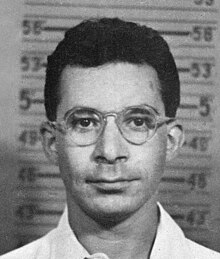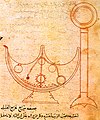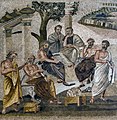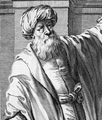Portal:History of science
The History of Science Portal
The history of science covers the development of science from ancient times to the present. It encompasses all three major branches of science: natural, social, and formal. Protoscience, early sciences, and natural philosophies such as alchemy and astrology during the Bronze Age, Iron Age, classical antiquity, and the Middle Ages declined during the early modern period after the establishment of formal disciplines of science in the Age of Enlightenment.
Science's earliest roots can be traced to Ancient Egypt and Mesopotamia around 3000 to 1200 BCE. These civilizations' contributions to mathematics, astronomy, and medicine influenced later Greek natural philosophy of classical antiquity, wherein formal attempts were made to provide explanations of events in the physical world based on natural causes. After the fall of the Western Roman Empire, knowledge of Greek conceptions of the world deteriorated in Latin-speaking Western Europe during the early centuries (400 to 1000 CE) of the Middle Ages, but continued to thrive in the Greek-speaking Byzantine Empire. Aided by translations of Greek texts, the Hellenistic worldview was preserved and absorbed into the Arabic-speaking Muslim world during the Islamic Golden Age. The recovery and assimilation of Greek works and Islamic inquiries into Western Europe from the 10th to 13th century revived the learning of natural philosophy in the West. Traditions of early science were also developed in ancient India and separately in ancient China, the Chinese model having influenced Vietnam, Korea and Japan before Western exploration. Among the Pre-Columbian peoples of Mesoamerica, the Zapotec civilization established their first known traditions of astronomy and mathematics for producing calendars, followed by other civilizations such as the Maya.
Natural philosophy was transformed during the Scientific Revolution in 16th- to 17th-century Europe, as new ideas and discoveries departed from previous Greek conceptions and traditions. The New Science that emerged was more mechanistic in its worldview, more integrated with mathematics, and more reliable and open as its knowledge was based on a newly defined scientific method. More "revolutions" in subsequent centuries soon followed. The chemical revolution of the 18th century, for instance, introduced new quantitative methods and measurements for chemistry. In the 19th century, new perspectives regarding the conservation of energy, age of Earth, and evolution came into focus. And in the 20th century, new discoveries in genetics and physics laid the foundations for new sub disciplines such as molecular biology and particle physics. Moreover, industrial and military concerns as well as the increasing complexity of new research endeavors ushered in the era of "big science," particularly after World War II. (Full article...)
Selected article -

The history of paleontology traces the history of the effort to understand the history of life on Earth by studying the fossil record left behind by living organisms. Since it is concerned with understanding living organisms of the past, paleontology can be considered to be a field of biology, but its historical development has been closely tied to geology and the effort to understand the history of Earth itself.
In ancient times, Xenophanes (570–480 BC), Herodotus (484–425 BC), Eratosthenes (276–194 BC), and Strabo (64 BC–24 AD) wrote about fossils of marine organisms, indicating that land was once under water. The ancient Chinese considered them to be dragon bones and documented them as such. During the Middle Ages, fossils were discussed by Persian naturalist Ibn Sina (known as Avicenna in Europe) in The Book of Healing (1027), which proposed a theory of petrifying fluids that Albert of Saxony would elaborate on in the 14th century. The Chinese naturalist Shen Kuo (1031–1095) would propose a theory of climate change based on evidence from petrified bamboo. (Full article...)
Selected image

Science, and particularly geometry and astronomy, was linked directly to the divine for most medieval scholars. The compass in this 13th century manuscript is a symbol of God's act of creation. God has created the universe after geometric and harmonic principles; to seek these principles was therefore to seek and worship God.
Did you know
...that Einstein's famous letter to FDR about the possibility of an atomic bomb was actually written by Leó Szilárd?
...that geology was transformed in the latter part of the 20th century after widespread acceptance of plate tectonics?
...that the idea of biological evolution dates to the ancient world?
Selected Biography -
Louis Alexander Slotin (/ˈsloʊtɪn/ SLOHT-in; 1 December 1910 – 30 May 1946) was a Canadian physicist and chemist who took part in the Manhattan Project. Born and raised in the North End of Winnipeg, Manitoba, Slotin earned both his Bachelor of Science and Master of Science degrees from the University of Manitoba, before obtaining his doctorate in physical chemistry at King's College London in 1936. Afterwards, he joined the University of Chicago as a research associate to help design a cyclotron.
In 1942, Slotin was invited to participate in the Manhattan Project, and subsequently performed experiments with uranium and plutonium cores to determine their critical mass values. After World War II he continued his research at Los Alamos National Laboratory in New Mexico. On 21 May 1946, he accidentally triggered a fission reaction which released a burst of hard radiation. He was rushed to the hospital and died nine days later on 30 May. Slotin had become the second fatal victim of a criticality accident in history, following Harry Daghlian, who had died of a related accident with the same plutonium "demon core" the previous year. (Full article...)
Selected anniversaries
- 901 - Death of Thabit ibn Qurra, Arab astronomer and mathematician (b. 826)
- 1535 - Death of Heinrich Cornelius Agrippa, astrologer and alchemist (b. 1486)
- 1745 - Birth of Alessandro Volta, Italian physicist (d. 1827)
- 1788 - Death of John Whitehurst, English clockmaker and scientist (b. 1713)
- 1838 - Birth of Ernst Mach, Austrian physicist (d. 1916)
- 1930 - While studying photographs taken in January, Clyde Tombaugh discovers Pluto
- 1957 - Death of Henry Norris Russell, American astronomer (b. 1877)
- 1967 - Death of J. Robert Oppenheimer, American physicist (b. 1904)
Related portals
Topics
General images
Subcategories
Things you can do
Help out by participating in the History of Science Wikiproject (which also coordinates the histories of medicine, technology and philosophy of science) or join the discussion.
Associated Wikimedia
The following Wikimedia Foundation sister projects provide more on this subject:
-
Commons
Free media repository -
Wikibooks
Free textbooks and manuals -
Wikidata
Free knowledge base -
Wikinews
Free-content news -
Wikiquote
Collection of quotations -
Wikisource
Free-content library -
Wikiversity
Free learning tools -
Wiktionary
Dictionary and thesaurus









































































